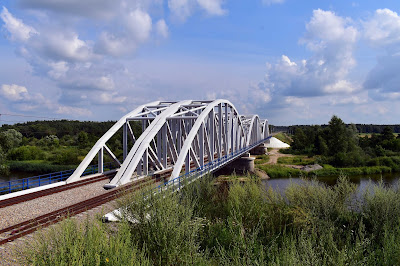Moni drove over to the działka, and we set off to Warka for lunch, and to see how the railway - and the town - is getting on. In brief - Warka station (1.7km from the town square) is ready - job done, platforms, underground tunnel, waiting room - everything complete. Likewise the new, two-track bridge carrying the Warsaw-Radom railway line over the Pilica river.
Still to do, the new station, Warka Miasto (a mere 700m from the town square). It's taking shape, not a major job (two platforms, access via stairs to the new viaduct taking ulica Lotników over the railway line).
Once it opens next spring, Warka will face the same question that many towns with their main railway station far from the centre have - why is that station named for the town located further away than a station much nearer the centre? John Betjeman's poem Great Central Railway springs to mind - "And quite where Rugby Central is/Does only Rugby know"... On the other hand, Warka gets upgraded to one of those Polish towns that has more than one station to its name.
Below: Warka Miasto ('Warka Town') station is located on a curve, just before the bridge over the river Pilica, visible in the distance. Two parallel platforms will straddle the two tracks (before the modernisation, there was only the one line from Warka to Radom). Note the huge pile of apple crates to the right. This is the heart of apple country.
Below: the view from ul. Lotników, looking toward the 'down' platform. What will no doubt delay the opening of the new station will be the installation of level-access lifts from the viaduct down to platform level. At W-wa Jeziorki, this took many months after everything else was ready. Putting in the lifts (for 'up' and 'down' platforms) is by far the most complex part of the remaining works.
Below: the new viaduct is open for road traffic, replacing a gated level crossing that had been here before - a similar situation to that at W-wa Jeziorki. All the ungated crossings on the line to Radom will disappear.
Below: the classic view of the two new bridges, replacing the single-track bridge that had been built here in 1934 (destroyed in WW2 and rebuilt after the war). While the new bridges were under construction, a replacement bus service linked Warka and Radom, meaning journey times from Warsaw to Radom were typically over three hours. Now the work's done, it's an hour and 20 minutes.
The new bridges are of the same design as the old bridge, but with more attention paid to flood prevention. Note the concrete buttressing to the right.
Below: the Pilica is a popular river for canoes, which in Polish are called kayaks. [In UK English, a kayak can be a canoe, but a canoe is typically open from bow to stern.] Today - a sunny Sunday in July - the river was full of small boats heading downstream in the direction of the Pilica's confluence with the Vistula, 17km/10.5 miles to the east.
Below: kayaking down the Pilica has become a big thing. All along the river bank, new hotels and tourist infrastructure has sprung up to cater for the sport. Along the road parallel to the Pilica you can see minibuses with special trailers that can carry ten or so kayaks; they travel empty downstream, and laden with kayaks upstream. Good to see so many people making the most of the weather and the river!
Below: a double-decker Koleje Mazowieckie train on its way from Radom to Warsaw approaches the bridge at Warka.
On the bridge itself - I assume we were not trespassing, as there were no signs prohibiting pedestrians from using the walkway on the western side. In the distance, the tower of the voluntary fire service station in Warka.
Below: I wrote about Warka station in June of last year - since then, the pedestrian tunnel has been completed, the station is ready. The waiting room has a machine serving hot drinks, including rosół (chicken broth), but no small bottles of chilled mineral water for summer. On the west side of the tracks, the tunnel is ready. Like at Chynów station, there are no lifts to platform level from the tunnel, only a set of long and gentle ramps, a more robust solution than lifts which are prone to malfunction. On the other side of the tracks from the station, there's no paved footpath, just muddy puddles. But then access from here to ul. Grójecka is the remit of the town, not of the railway.

We ate at a restaurant called Kociołek, located at the foot of a block of flats some way from the market square. The food was excellent, but what a bill! For two main courses, one prawn starter and two half-litres of 0.0% beer, the bill came to 95 złotys (£17.82). Four years ago, my father, Moni and I lunched in Mogielnica, a small town 32km/20 miles west of Warka, where cold beer, half-litre, two sparkling mineral waters, two soups and three massive main courses came to 52 złotys (£11.17). Inflation is letting rip in Poland, made worse by the effect of the pandemic. Google Maps was still showing us restaurants in Warka that are no longer in business.
This time last year:
















No comments:
Post a Comment